

We’re all used to playing the lone Starfighter in a fight to save the galaxy against some unknown evil. Even in the few multiplayer space shooters most players are forced into the same niche role. While this generally makes sense from both a scale and an entertainment perspective, sometimes it would be fun to jump into a massive capital starship and just blow the crap out of some space stations or equally powerful vessels. Unfortunately, there are only a handful of games that cater to this scenario, with EVE Online being the most prevalent but not quite providing the same experience as an actual shooter.
Thankfully, however, Dreadnought has seen this massive gap in the market and is creating a team-based shooter that incorporates large-scale spaceships. The smallest being the still slightly maneuverable corvette to the massive, heavy dreadnought. While providing a capital starship experience, Dreadnought has still managed to flesh out the individual roles so well that no two ships feel the same. There are support ships with repair capabilities, quick corvettes that can warp around the battlefield, devastating snipers, and of course varying tiers dreadnoughts, the floating armored fortresses.
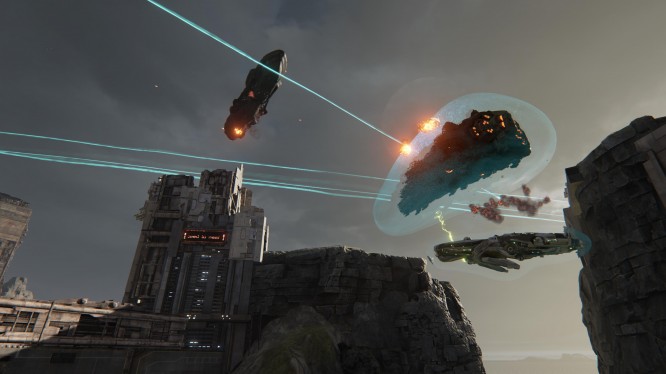
Although I’ve seen Dreadnought in action at previous conventions, this was the first time I had the opportunity to experience the game first hand. The idea definitely sounded appealing to me, but I was definitely skeptical at first. Piloting a gigantic dreadnought around sounds fun at first, but previous experiences have shown that it’s the smaller fighters that usually get the most action. In EVE Online, for example, capital ships are rarely seen and more often than not they’re forced into support roles or are forced to sit and siege a spaceport for a few hours on end. So the challenge for Dreadnought is to create a relatively genuine experience without all the boring nuances associated with hauling a floating space carrier around.
My first battle in Dreadnought was a typical 5vs5 deathmatch. I was dropped into a game with 4 other players filling various roles, but overall the mode had a very casual feel to it. The first ship I was instructed to test out was a heavy sniper class. Unlike most other ships in the game, this one required very specific positioning to fire its main gun. Although Dreadnought acts more like a FPS than space simulator, the vertical axis allows players to have full 360 view around their ships and this normally allows for a wide arcing range of fire. The artillery cruiser, however, was designed to specially fire straight ahead, which leaves it incredibly vulnerable if attacked from the side or behind.
The sheer firepower of the sniper quickly makes up for its lack of maneuverability or firing limitations. In my first match I was able to quickly burst down a corvette with only two hits in siege mode. It only took a few more shots to bring down the enemy’s support ship, and I eventually took down a dreadnought before a crafty corvette finally got through my armor. Before respawning I decided to give the corvette a test for myself. I was amazed with how much different the two ships handle. The previous, bulky sniper ship had nothing on the speed or handling of the corvette. I was zipping around the battlefield taking shots at enemy ships, enjoying my new found speed, when all of a sudden I was nothing more than floating debris. The increase speed was definitely compensated for with significantly less armor.
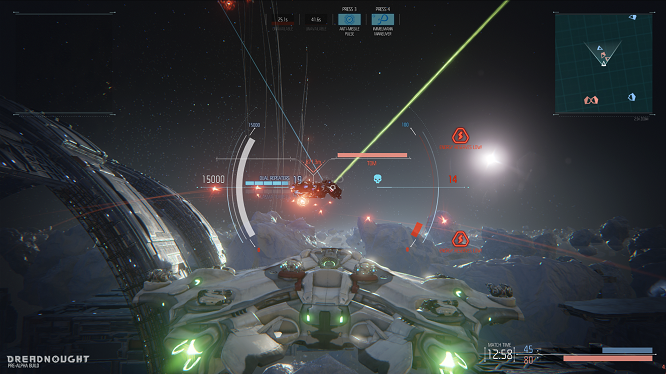
Finally, I tried my hand at a flagship dreadnought equipped with a broadside alpha strike and homing missiles. The Dreadnought is great for players who really want to get into the middle of the action and don’t want to worry about trying to avoid damage. Just divert power to shields when things get intense and unload your payload on all nearby enemies. It might not be the class with the most finesse, but it definitely gets the job done.
While team deathmatch is definitely a lot of fun, the real competition comes out in the Team Elimination mode. Similar to Counter-Strike, Team Elimination gives each member on a team one life and that’s it. However, if taken out of the fight your ship is replaced with a much smaller Starfighter that can still do a small amount of damage and, if nothing else, at least draw enemy fire. In my first match of Team Elimination I chose a heavy artillery cruiser, specializing in sniping abilities. I quickly picked off the enemy corvette headed for my backline and moved on to the enemy support ship. After that it was just a matter of cleaning up the remaining dreadnought and enemy artillery cruiser.
On the second round, however, the enemy sniper dialed in on me as I attempted the same strategy. I was blown to pieces within a few seconds of the round and was forced to spend the rest of the fight harassing the enemy’s support cruiser. The Starfighters handle in a very similar fashion to the corvettes, but have significantly less firepower and don’t really have any abilities. If left alone, however, they will eventually bring down a much larger target that isn’t being healed or diverting power to shields, so they’re not entirely useless. During the final match of the best-of-three, I decided to hide out for a bit waiting for the enemy sniper to show its face. Eventually he attempted to burn down our dreadnought and that’s when I made my move. After diverting full power to guns and sieging up, I made quick work of the enemy sniper. The remainder of the match was a little back and forth, but we pulled out ahead with just myself and one other dreadnought remaining.
Pulling off the victory was a great feeling, but simply getting a taste of Dreadnought wasn’t enough. The game is both exciting and addicting, but I haven’t even begun to scratch the surface with ship builds. There are four separate modules for each ship and there are a decent amount of options, adding up to quite a variety of loadouts. Not to mention that each class has 4 or 5 sub-classes as well. Dreadnought might not only be the best space game that comes out next year, but it could very well be the best overall PvP shooter.



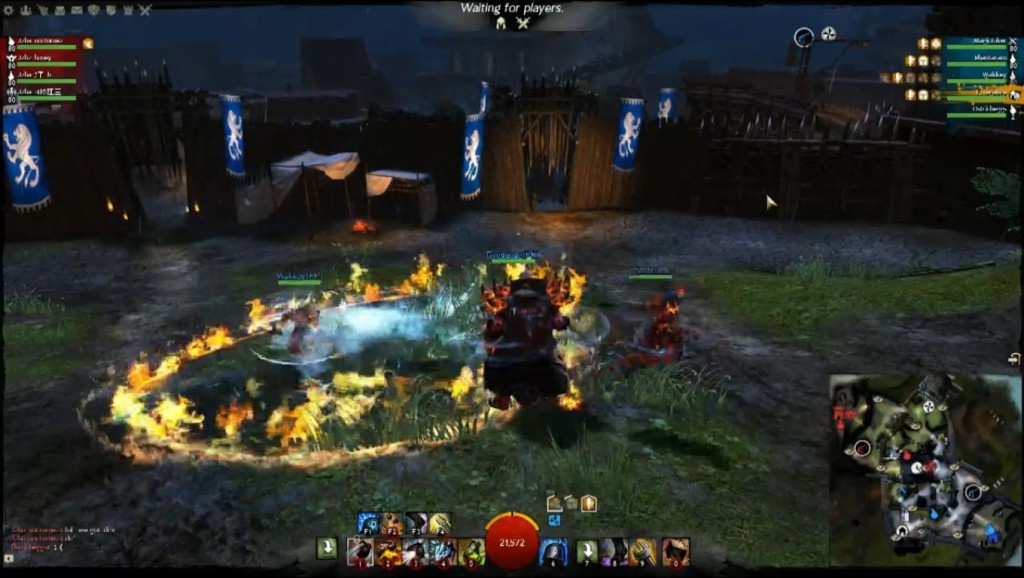
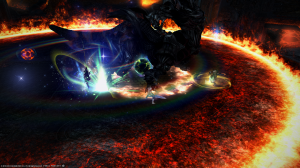 Final Fantasy XIV - The RPG in an MMORPG .
Final Fantasy XIV - The RPG in an MMORPG . Agar.io: Some Tips for Giant Cells
Agar.io: Some Tips for Giant Cells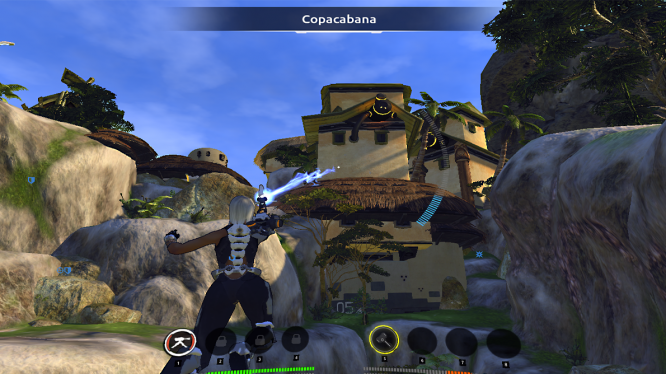 Scott Youngblood Firefall Interview: Your Game, His Words .
Scott Youngblood Firefall Interview: Your Game, His Words . Beta Data: March 14, 2014 .
Beta Data: March 14, 2014 .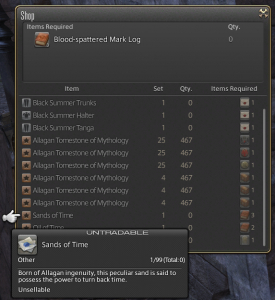 Final Fantasy XIV - One Bad Apple Spoils the Hunt .
Final Fantasy XIV - One Bad Apple Spoils the Hunt .